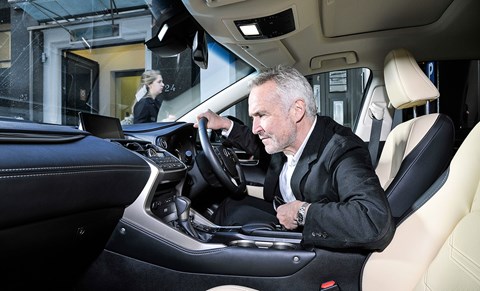► Month six living with the Lexus NX300h
► We get some design expertise in to critique the NX
► Design critic Stephen Balyey lends a helping hand
Bafflement at the rationale behind the NX300h’s hybrid drivetrain leads to classic compensation on a ‘bald man grows beard’ scale. Let’s forget how weird it is to drive and concentrate instead on seeking the finer points or, as Apollo 13 mission controller Gene Kranz apparently stated while assessing the Big Crisis, ‘what have we got on the spacecraft that’s good?’
Well, the Lexus’s interior is certainly good – so much so it almost takes your mind off the thrashing and whining going on under the hood as the electric gearbox holds a lengthy meeting to discuss whether the throttle’s horizontal position establishes a clear case for changing up. But man cannot live by leather chairs alone.
So I turn to design, a facet of the NX’s personality that sits pretty high up in the mix and divides opinion Corbyn-like. Tentatively of the view that I like these looks yet acknowledging my appreciation limitations, I turn to the foremost mind on the subject of automotive art, Mr Stephen Bayley. Tom Wolfe said of Bayley: ‘I don’t know anybody with more interesting observations about style, taste and contemporary design.’ Perfect! So what does Stephen make of my long-termer?
‘Henry Ford said you can read any object like a book,’ he says. ‘That’s certainly true of the Lexus NX. It has a beginning, a middle and an end, but the conclusion is indecisive and the plot extremely vague.
‘In nearly 30 years Lexus has failed to develop a consistent or even persuasive design language. At one point, Lexus liberated itself from an early slavish adherence to doing cargo-cult S-class Benzes, but this emancipation led to aesthetic chaos. What they do now in design is both good and original. The good bits are not original and the original bits are not good. It’s a mash-up where the whole is less than the sum of the parts.’

Bayley’s a man incapable of being visually fazed, yet his expression on first acquaintance with the NX’s frontal aspect borders on disparaging. ‘The beginning of the NX, its face, looks as though an already enraged samurai has experienced blunt force trauma. True, there is an in-house tradition of evocative faces beginning with the 1936 Toyota AA, via the Toyopet Crown of 1955 and the weird domestic market Toyota Verossa of 2003 with a koi carp pout, but the NX is strange without being interesting.
‘They will tell you, and the credulous will dutifully repeat, that the grille is a “spindle”, perhaps a knowing reference to Toyota’s history in the loom business. But it is an attempt to establish character where none really exists. For all the world, it looks like a class of undergraduate designers was briefed to give the NX powerful DTRG, industry demotic for “down the road graphics”. It is meant to look impressive. Instead, it simply looks cross which is no great evolutionary advantage for a sluggish car with modest overtaking credibility.’
Modest is too kind a word – the itself unboastworthy 9.2sec 0-62mph time masks an in-gear torpidity that banishes friskiness as decisively as a flannelette nightie. The secondary force needed for overtaking is not either of the electric motors but a more natural phenomenon known as momentum. Without it, simply keep left.
But I want Bayley – a notable commentator on architecture – to explain to me the purpose of the multi-faceted detailing on the NX, which marks it out from the slab-flanked Prius parked in the next bay. I mean, it does have a purpose, right?
‘The “jewellery”, with details rushing around like a Japanese fire drill, is also a cry for help,’ Bayley points out. ‘Of course, rationality never had much real connection with design of any sort, but any even residual relationship has here been cruelly broken. The curious comings and goings of front and rear lenses and reflectors with their slashes, ticks, strakes and zig-zags look like a mad woman’s breakfast. Ask yourself what Jonathan Ive would have done and then take pause to wonder if the NX ever had a design review. And if it did, what on earth did they reject in favour of this?

‘The body sides are a roiling ocean of troughs and swells, indicative in today’s market of “premium”, so at least a commercial point is proven by the agitated surfacing. There are detail curiosities too: look at the little blip on the trailing edge of the plastic liner of the rear wheelarch – between us we have about 70 years of collective expertise in looking at cars and we’re left confused and wondering.’
He has a point – what can this tiny plastic nodule possibly add to 1.7 tonnes of steel and batteries? Either Adrian Newey popped in with a last-minute idea to knock off 5mpg or maybe a Lexus suit cemented his perceived usefulness for at least another product lifecycle by suggesting it. We may never know. Ultimately though, this isn’t about taste, it’s about execution, about fitness for purpose. Has Lexus aced it?
‘Cars are not only like books, they are like cathedrals as well,’ says Bayley. ‘And architectural criticism helps us understand the design of the NX. On the whole, it is about “complexity and contradiction”, to hijack the title of Robert Venturi’s post-modern manifesto of 1966. And the details amount to no more than “featurism”. This was the term Robin Boyd used in his landmark 1960 book The Australian Ugliness to describe those pitiable diddles and squiggles architects do when they have no real ideas about proportion or sculpture or detail.
‘But the successful design of any car always depends on the underlying integrity of its concept. The NX is beautifully made, but poorly conceived: even experts cannot understand what its drivetrain is trying to do or what the car is actually for. Artistically, the best Lexus was Giugiaro’s original GS. This was sold in Japan as the Toyota Aristo, a name suggestive of yearnings for elegance and refinement that the visually noisy NX fails to achieve.’

At which point we arrive at the reason why it’s proving such a struggle to fall for this Lexus – I simply don’t know what it’s for. The paradoxes flock – everywhere you look there’s a question. Why fit a head-up display to keep the driver’s eyes on the road, yet make the touchpad controller so sensitive you cannot operate it while concentrating on driving? Why develop a complex drivetrain to help the environment, with a CO2 output double that of the London congestion charge exemption limit? Why abandon peerless refinement – the one nailed down brand value this still-fledgling badge had achieved, in favour of a whiny engine and much wind noise? Stephen Bayley – described by The Guardian as ‘the second most intelligent man in Britain’ – has no idea. And neither do I.
From the driving seat
+ Cabin a wonderful place, with chairs from a £100m yacht
– Even Bletchley Park couldn’t decode the drivetrain
+ Ride, composure and body control impressive
– Hair-trigger touchpad
+ The steering! It’s nicely judged
Logbook: Lexus NX300h Premier
Engine: 2494cc 16v 4-cyl, 153bhp @ 5700rpm (195bhp with electric motor), 148lb ft @ 4200-4400rpm
Gearbox: Electric CVT, four-wheel drive
Stats: 9.2sec 0-62mph, 112mph, 121g/km CO2
Price: £42,995
As tested: £44,640
Miles this month: 870
Total: 8388
Our mpg: 38.9
Official mpg: 54.3
Fuel this month: £148.05
Extra costs: £0